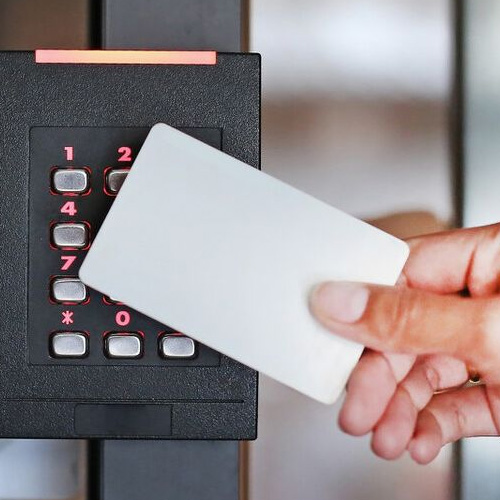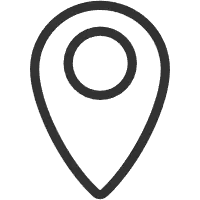
What is RFID card meaning? RFID card is Radio Frequency Identification card, also known as contactless IC card or contactless card.
RFID card is a kind of card containing RFID chip, this chip can communicate with the reader through radio waves, and the information inside the card can be read without direct contact or visual range.
RFID cards can be categorized into different types, based on different frequencies, the common ones are low-frequency cards (e.g., ID cards, with an operating frequency of 125 KHz), high-frequency cards (e.g., IC cards, with an operating frequency of 13.56 MHz), and UHF cards (with an operating frequency of 860 MHz to 2.4 GHz). These cards can be used not only for identification, but also for storing and modifying data, usually from a few centimeters to a few meters, depending on the technology and operating frequency. Making them extremely useful in application scenarios where individuals or objects need to be identified.

Components of an RFID Card.
The structure of RFID card includes Antenna, Chip and Package.
Among them, the antenna is RFID card and read-write between the medium of transmission of information, is responsible for receiving read-write signals and chip in the information stored in the radio waves to send to the read-write; chip is the core component of the RFID card, including microprocessors and memory, negative wheat on the information processing and storage; package is the RFID card and chip packaging.
Chip is the core component of RFID card, including microprocessor and memory, negative wheat for information processing and storage; package is the antenna and chip packaged together, to protect the internal structure of the RFID card, and at the same time, convenient for the use and management of RFID card.
How Do RFID Cards Work?
The basic working principle of an RFID card is to realize the reading and writing of the information stored in the chip through radio waves. The chip of the RFID card contains an antenna, a microprocessor, and a memory.
1. When the RFID card is in the reader within the sensor range, the reader will send a command to the RFID card.
2. The RFID card receives the instruction, which will be stored in the chip information through the antenna sent to the reader.
3. After receiving the information, the reader will decode it and transmit it to the computer for processing.
The reading distance of an RFID card is affected by many factors, such as the size and power of the antenna and the frequency of the reader. Generally speaking, the reading distance is between a few centimeters and several meters. Since RFID cards use radio waves, care needs to be taken to avoid problems such as interference and signal eavesdropping during use.
What Is An RFID Used For?
1. Identification and Verification
· Access control system: RFID cards can be used as the identity credentials of employees to realize fast and accurate identity verification and enhance the security of the office area.
· Public transportation: bus cards, subway cards, etc., to facilitate the travel of passengers, to achieve rapid payment and verification.
· Medical field: used for patient identification to ensure the accuracy and safety of medical services.
2· Data tracking and Management
· Logistics management: RFID cards can be affixed to goods to realize real-time tracking and monitoring of goods, improve logistics efficiency, and reduce the risk of loss and misdirection.
· Inventory management: In the retail industry, RFID cards are used to quickly inventory the quantity of goods, reduce manual errors, and improve inventory turnover.
· Asset management: RFID tags are affixed to valuable items or equipment to monitor the location of assets in real-time and effectively prevent loss.
3. Payment and Transaction
· Intelligent payment: Many cities' bus and subway systems use cards with built-in RFID chips, and passengers only need to bring their cards close to the card reader to complete payment, greatly reducing the time spent in line for tickets.
· Self-service checkout: some retail stores use RFID tags to realize self-service checkout, customers only need to buy goods in a specific settlement area, and the system can automatically identify and calculate the total price, simplifying the shopping process.
4. Safety and Security
· Access control: In addition to identity verification, RFID cards can also be combined with security systems to achieve regional location management and security alarms.
· Military/national defense/national security: the dynamics of some important military medicines, guns, ammunition, or military vehicles need to be tracked in real time, and RFID cards play an important role in such applications.
5. Other Applications
· Library management: RFID cards are used for borrowing, returning and inventorying books in libraries to improve management efficiency.
· Anti-counterfeiting and traceability: RFID cards are used to record the production and circulation information of products to realize anti-counterfeiting and traceability and to protect the rights and interests of consumers.
How Do I Know If My Card Is RFID?
1. Check the Appearance of the Card:
RFID cards usually have a built-in chip and may have special markings or logos on the back of the card indicating that it is an RFID card. These markings may include specific textual descriptions, such as the word “RFID” or a related logo pattern.
2. Detection Using a Cell Phone:
If your cell phone supports NFC (Near Field Communication), you can try to detect the card using the NFC function of your cell phone. After turning on the phone's NFC function, try to bring the phone close to the card, if the phone can recognize the card and display relevant information, then the card is likely to be an RFID card.
3. Mobile Phone App Detection:
Many companies or organizations have developed a special RFID identification cell phone APP, through the cell phone's built-in NFC chip or other wireless communication technology, able to read the information of the RFID tag. Users only need to download and install the corresponding APP, they can easily identify RFID tags, convenient and practical.
4. RFID Access Control System:
Many enterprises, institutions, or public places use RFID access control systems to manage people in and out. These systems usually include RFID readers and RFID tags.
Users only need to contain RFID chip tags near the reader, which can be recognized. Therefore, if you are asked to use RFID tags for identification when passing through an access control system, then you can be sure that the card or tag you are holding is an RFID tag.
RFID Card vs NFC Card.
| Differentiation | RFID Card | NFC Card |
| Working Principle | RFID technology through radio waves and electronic tags for non-contact data exchange, the realization of the automatic identification of objects. RFID tags attached to the object, storing the object's unique identification and related data; readers through the transmission of radio frequency signals to activate the tag and read the data in the tag; the APP system is responsible for the processing of these data, the realization of the object's tracking, management and control. | What is NFC? NFC card‘s technology is a short-range, high-frequency wireless communication technology that allows electronic devices to exchange data contactlessly in very close proximity (≤10 cm). |
| Composition | Tag + Reader + APP System | The NFC device integrates the reader and card functions of RFID technology internally and can be used as an RFID reader and card at the same time. |
| Frequency Difference | LF(125KHz or 134.2KHz), HF(13.56MHz), UHF(860-960MHz) | HF(13.56MHz) |
| Communication Distance | RFID Cards operate over relatively long distances, typically between a few meters and tens of meters. | NFC Cards work at a relatively short distance, usually within 10cm. |
| Uni-Bi-Directional Communications | RFID is usually only a one-way communication (from tag to reader) and can scan multiple tags at once. | NFC allows two-way communication and only one tag can be scanned at a time. |
| Communication Speed | Slow, usually between tens of kbps and hundreds of kbps. | Fast, NFC can communicate at speeds up to 424kbps. |
| Security | Are RFID cards safe? RFID communication distance situation, other devices can also be in a very long distance to capture the RFID information, there are insecurity factors. | NFC is only limited to the 13.56MHz. NFC works at an effective distance of about 10cm, so it has a high level of security. |
| Compatibility | Various standards exist for RFID technology, such as ISO/IEC 14443, ISO/IEC 15693, EPC Class 1 Gen 2, and others. Different standards and poor compatibility. | NFC technology is based on the ISO/IEC 14443 standard and is compatible with high-frequency RFID standards. |
| Application Scenarios | RFID technology is widely used in logistics, warehousing, retailing, identification, personnel tracking, access control, supply chain management and other fields due to its long-range identification, tracking of target location and large data capacity. | NFC technology is commonly used in mobile payment, access control, public transportation card swiping, data transmission and other scenarios due to its proximity communication and mobile payment characteristics. |
| Equipment Costs | Cheaper | More Expensive |

